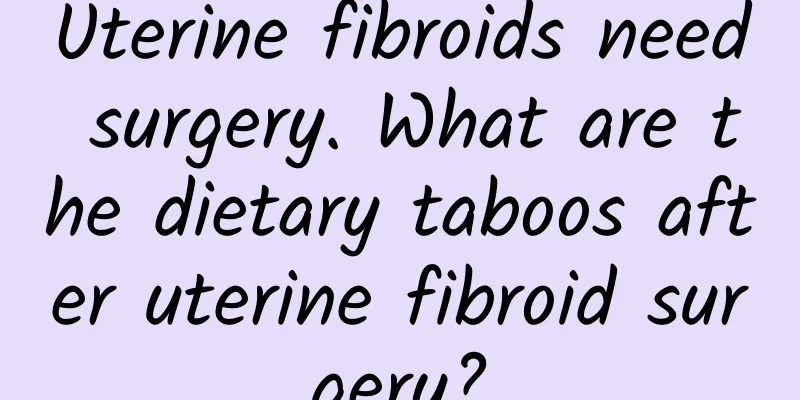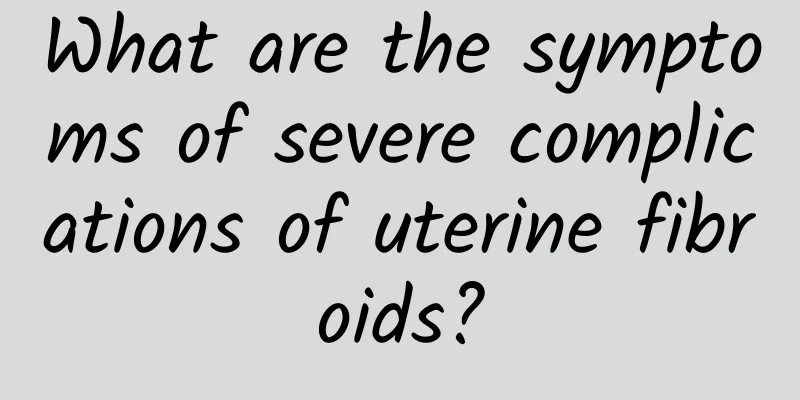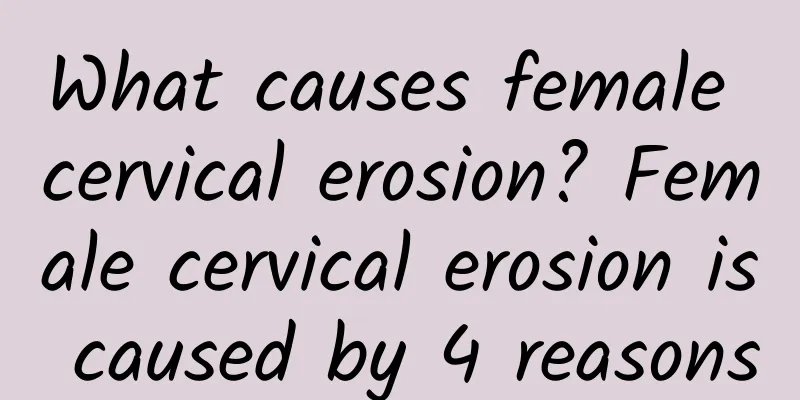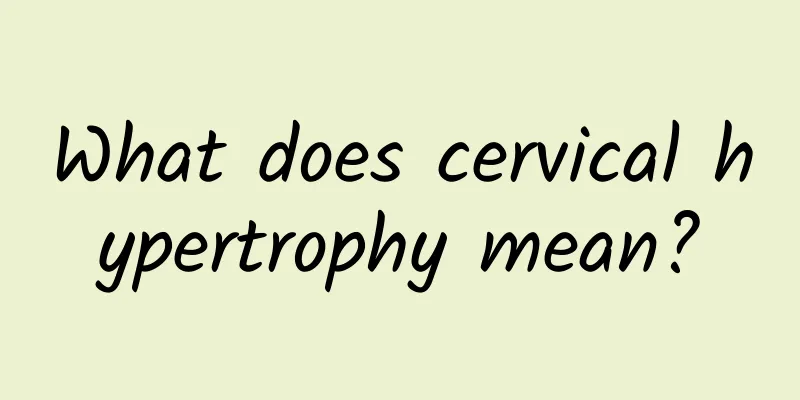Uterine fibroids need surgery. What are the dietary taboos after uterine fibroid surgery?

|
Uterine fibroids are the most common benign tumors in women. They are composed of smooth muscle and connective tissue, so they are also called uterine leiomyoma. Common symptoms include uterine bleeding, abdominal mass, vaginal discharge, and bladder and rectal compression symptoms. The origin of uterine fibroids and the mechanisms that promote their growth are still poorly understood. It is currently believed that the transformation process from myometrial cells to myoma formation may involve a complex interaction between somatic mutations of normal myometrium, sex hormones, and local growth factors. Due to people's lack of correct understanding of uterine fibroids, many women panic when they hear that they have fibroids in their uterus; some patients suffer from anemia due to uterine fibroids, or even have serious conditions, but are still unwilling to undergo surgery. Do uterine fibroids affect sexual desire? First of all, patients with uterine fibroids suffer from severe anemia due to excessive menstruation and prolonged menstruation. Patients experience anemia symptoms such as dizziness and fatigue, and their sexual desire also decreases. 2. If patients with uterine fibroids use hormone therapy, such as progesterone, testosterone propionate and methyltestosterone, it may lead to a decrease in sexual desire; norethindrone has an androgen-like effect and can also lead to a decrease in sexual desire. 3. 25% to 30% of patients with uterine fibroids cannot get pregnant, but after the fibroids are removed, patients who have been infertile for many years often get the fruit of their dream. The couple is overjoyed and their sexual desire suddenly increases. 4. For patients with uterine fibroids, such as hysterectomy and bilateral oophorectomy, sexual desire may decrease after surgery. This is mainly caused by the decrease of estrogen and menopausal syndrome after oophorectomy. How big a uterine fibroid needs surgery? Experts point out that the treatment of uterine fibroids depends on the specific situation of the patient, and the size of the fibroids is only one aspect. Whether the patient needs surgery also depends on factors such as the nature, number, growth location, speed, age, and fertility requirements of the uterine fibroids. Generally speaking, when the fibroids are small (4 CM or larger) and the patient has no obvious symptoms, follow-up observation can be chosen every 3 to 6 months; for patients with larger fibroids (4 CM or larger) or those growing too fast, drug treatment is often ineffective. Therefore, patients with large fibroids that grow too fast are often treated with surgery. Surgical treatment of uterine fibroids is divided into abdominal surgery and minimally invasive surgery. The laparotomy for uterine fibroids includes total hysterectomy and myomectomy. However, due to the need for laparotomy, it may damage other tissues in the body, which in turn affects women's normal condition. At present, with the development of minimally invasive gynecological surgery, most patients know about minimally invasive treatments that preserve the uterus and remove fibroids. Minimally invasive treatment of uterine fibroids is generally divided into interventional surgery and laparoscopic surgery. Laparoscopic minimally invasive technology only requires 3-4 small incisions of 0.5-1 cm in the abdomen, and then inserting a laparoscope. The surgery does not require the abdomen, has little trauma, and the patient recovers quickly. It will not reduce the patient's own immunity and is not easy to get infected. Superconducting ablation minimally invasive technology can preserve the uterus and remove fibroids without surgery or hospitalization. The surgery will not cause abdominal or pelvic adhesions, and can maintain the integrity of female reproductive organs such as the uterus, maintain female fertility and a harmonious married life. Experts emphasize that the uterus is not only a female reproductive organ, but also a complex endocrine system. Blindly removing uterine fibroids will not only cause endocrine disorders, but also lose the right to become a mother. Therefore, once fibroids are found, superconducting ablation minimally invasive surgery should be selected as much as possible under the guidance of a doctor for intrauterine protection treatment to restore health. What should I not eat after uterine fibroid surgery? 1. Avoid irritating foods and drinks such as chili peppers, peppers, raw onions, raw garlic, alcohol, and frozen foods. 2. Avoid eating foods that are hot, blood-clotting, or contain hormones, such as longan, red dates, donkey-hide gelatin, and royal jelly. Traditional Chinese medicine focuses on regulation. Traditional Chinese medicine believes that uterine fibroids are caused by organ dysfunction and qi stagnation and blood stasis. Blood and qi imbalance is a characteristic of uterine fibroids. Zhulin Temple Tumor Softening Cream focuses on distinguishing qi and blood when treating uterine fibroids. Through the principle of external treatment for internal diseases, the cream is applied to the acupuncture points of the human body, mainly to promote blood circulation and remove blood stasis, eliminate blood stasis and disperse knots, clear away heat and detoxify, soothe the liver and regulate qi, remove blood stasis and relieve pain, soften the tumor, and completely dissipate it. |
>>: Does uterine fibroids require surgery? What are the surgical treatments for uterine fibroids?
Recommend
Stop punishing yourself with dieting! Nutritionists teach you how to fix overeating
Nutritionist Zhao Hanying reminds us that health ...
What should a young woman do if she also has uterine fibroids? What should a young woman do if she has uterine fibroids?
According to research, uterine fibroids threaten ...
There are several main treatments for multiple uterine fibroids:
Multiple uterine fibroids are a type of uterine f...
Nursing care of patients with hyperprolactinemia in summer
Hyperprolactinemia seriously affects women's ...
Acute and chronic cervicitis will show up in leucorrhea
Acute and chronic cervicitis will show up in vagi...
Self-diagnosis of ectopic pregnancy
Ectopic pregnancy refers to the fertilized egg be...
Common manifestations of uterine fibroids
Among the many gynecological diseases, uterine fi...
Local weight loss: 9 parts of your body can be easily slimmed down
The weight loss methods for different parts of th...
Common causes of cervical hypertrophy
Cervical hypertrophy is one of the most common di...
It’s easy to lose weight in winter, and these five types of food can improve your metabolism! Nutritionist Zheng Xiuqing: Eating the right nutrients is the best
I often hear women over 40 sighing that they have...
What is irregular menstruation? 10 common treatments for irregular menstruation
How to treat irregular menstruation is a common g...
Introduction to the causes of cervical precancerous lesions
Cervical precancerous lesions are one of the most...
What are the symptoms of female cervical erosion?
Cervical erosion is one of the common cervical di...
Will I still have menstruation if I have an ectopic pregnancy?
Will I still have menstruation if I have an ectop...
Life-saving foods to prevent colorectal cancer! Cabbage and garlic can fight cancer
Variety show king Zhu Geliang was recently admitt...









